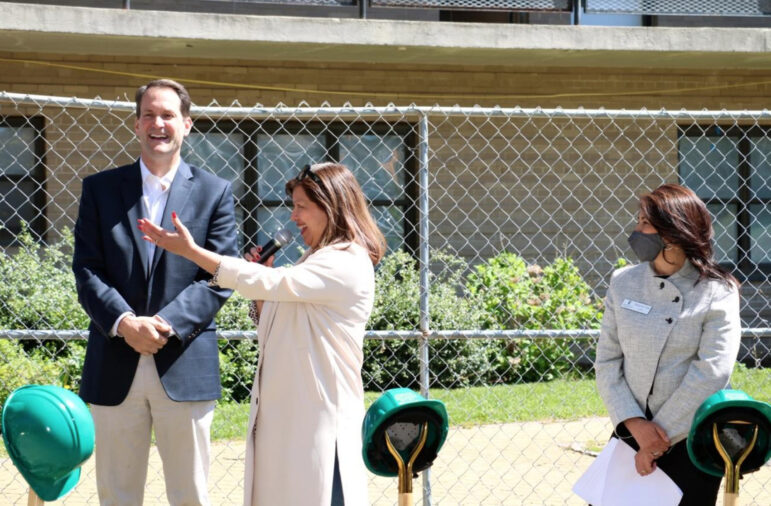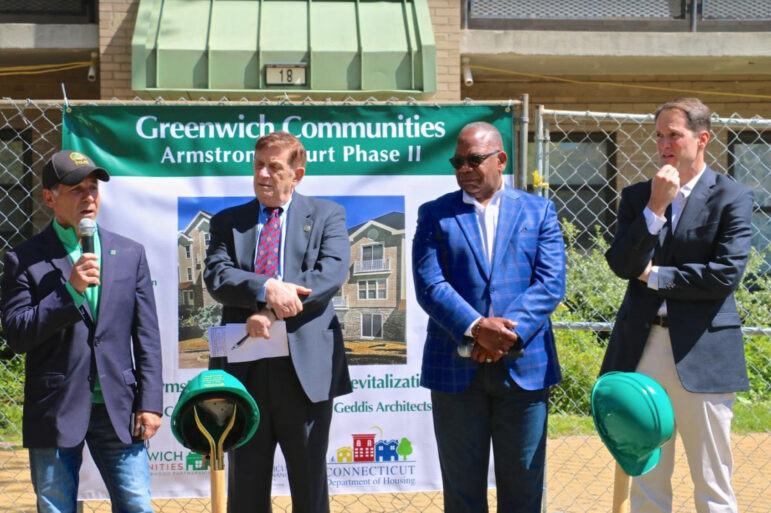Greenwich Communities held a groundbreaking ceremony on Saturday to celebrate the beginning of Phase II of a multi-phase rehabilitation of its Armstrong Court Development. Through the strong partnerships Greenwich Communities has forged with the State and Federal government, the project is another step forward for the Town
of Greenwich in expanding its affordable housing inventory. The cost of the 42-unit project is $27 million.
Phase II of Armstrong Court is the rehabilitation of Buildings 1, 3, and 6, which will resemble the new 18 townhouses constructed last year as part of Phase 1.
This next phase will bring both visual enhancements such as changing the rooflines and physical improvements like transforming current external living spaces into much-needed internal ones to create more 3-bedroom units to better accommodate the needs of families. An additional feature will be the addition of ADA-accessible units. The project will also improve energy efficiency and will receive $78,000 in energy rebates.

In attendance at Saturday’s groundbreaking were US Congressman Jim Himes, Town of Greenwich First Selectman Fred Camillo, and Selectperson Jill Oberlander, CT State Representatives Stephen Meskers and Kimberly Fiorello, Former State Representative Livvy Floren, former First Selectman Peter Tesei, and Former Selectman John Toner.
They were joined by CT Department of Housing Commissioner Seila Mosquera-Bruno, Masouda Omar from Connecticut Housing Finance Authority (CHFA), George Yankovich, Project Coordinator, and Greenwich Communities Commissioners: Chairman Sam Romeo, Jim Boutelle, Angelo Pucci, Vin DeFina, Bob Simms, and Cathy Landy; RTM Members Linda Moshier and Irene Dietrich, General Contractors Anthony Gaglio, Sr., Anthony Gaglio, Jr. and Pat Moughty from Viking Construction, Inc.
Greenwich Communities, formerly known as the Housing Authority of Greenwich, differs from other housing authorities because of its in-house expertise, explained Anthony Johnson, CEO and Executive Director of Greenwich Communities.

All of the development and financial engineering is performed in-house. Johnson described the “transformation” of Phase II as rectifying the challenges families have had with previous living space. He thanked former Commissioner and Project Coordinator George Yankovich and Consultant Lou Trajcevski from Newcastle Housing Ventures, adding that significant improvements at Armstrong Court have not been seen since the 144 units were constructed in 1951.
Chairman Sam Romeo credited the dedicated Greenwich Communities staff and the countless volunteer hours set forth by the Board of Commissioners, who are committed to continuing to create affordable housing opportunities in Greenwich. Romeo also proudly pointed to their close working relationship with the Town of Greenwich Departments; “we are truly a partner so we can do other projects. They allow us to do what we do.”
Congressman Jim Himes described the origins of his “own season of service,” which started 20 years ago as a new Commissioner of the then Greenwich Housing Authority, which he found “profoundly gratifying.”
Fast forward to 2021, Himes described the results of the tremendous effort of Greenwich Communities in one word: opportunity. “The residents who live here (in Armstrong Court) in the Town of Greenwich;
they become part of our family, and they go to Greenwich schools. That is an opportunity; that is a community, and that is family.”
Himes credited the leadership at the municipal, State, and Federal levels. “Quite frankly projects like this happen because you have leadership…because there is a partnership,” he said. “That is where opportunity comes from…thank you, Greenwich, for showing the world how you create opportunity.”
The opportunity Greenwich Communities strives for was further praised by Masouda Omar, Managing Director of Multifamily Housing Development for CHFA. “Armstrong Court is an endorsement for the belief that affordable housing will be transformational for the residents. You and your partners are creating a vibrant community where people can build the lives they want, plan for the future and celebrate their milestones.”

For CHFA, Armstrong Court is a significant investment, described Omar. CHFA is providing $5.3 million in tax-exempt bonds and $7.3 million in construction loans. Additionally, CHFA awarded 4% tax credits which are generating approximately $8.6 million in equity. The project received further support of $4.8 million from the Department of Housing and $500 thousand in tax state credits. Omar reminded the attendees of the project’s win/win proposition; “investing in affordable housing creates job and economic activity in the community, and we estimate that 76 jobs will be generated along with an estimated $29.4 million in economic activity.”
The 144-unit Armstrong Court redevelopment project consists of 4 phases with no existing residents relocated outside of the property.
Phase I of the project began in May 2019 and was completed in June 2020, with newly constructed townhouses finalized at the cost of $15 million. After Phase II, Phase III will be a single building consisting of 42 units.
Construction will start in late 2021-early 2022 with an expected cost of approximately $25 million. Phases 1 through 3 represent an all-in investment of $64 million in Armstrong Court.
Phase II will include combining the current one-bedroom and two-bedroom units to create three-bedroom and two-bathroom apartments. The larger units are in high demand by families and will provide a higher standard of living. Phase II is expected to take approximately twelve months. Additional features and amenities in each building will include expanded living space, cosmetic enhancements, the addition of air conditioning, electrical and insulation upgrades, improved rooflines, and the creation of new and renovated meeting and laundry facilities.
State of Connecticut Housing Commissioner Seila Mosquera-Bruno said the Department of Housing had contributed almost 5 million dollars. She noted that Connecticut has committed. “To make it work and to go fast; we are trying to be efficient, and we are trying to align our resources so we can maximize the results and get the shovels in the ground sooner rather than later,” she said.
First Selectman Fred Camillo expressed his gratitude to Romeo, Johnson, the Commissioners, and staff. He said, “Greenwich Communities continues to lead the way.”
